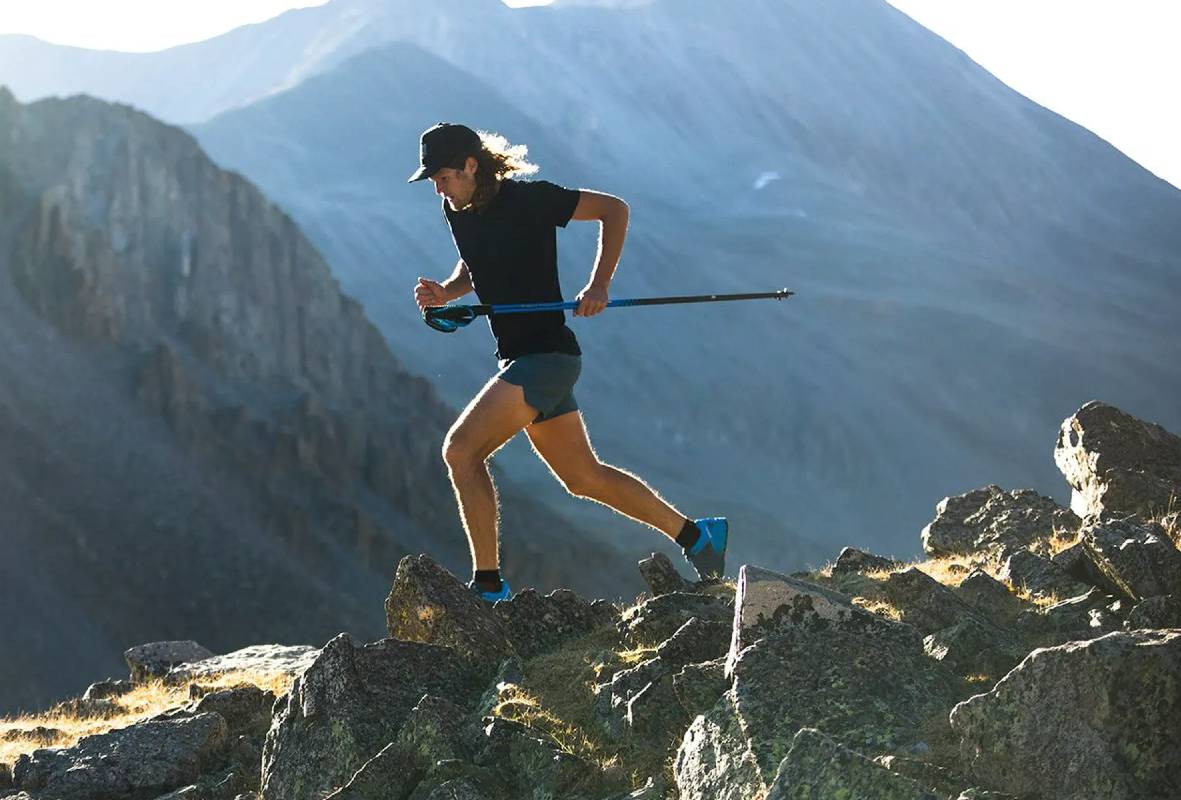The Ultimate Guide to Ultralight Trekking Poles
Posted by Mark Richardson on Apr 18, 2022

First of all - Why use trekking poles?
Using trekking poles splits the load between your legs and arms, its not an even split, your knees still take the lion's share of the stress of walking and carrying a load, but by transferring at least some of this to the arms your legs get some relief and at the end of a long day they aren't as tired as they would have been.
Trekking poles are particularly useful for ascending slopes where the extra push from your arms can be a real help. They are also good for balance on uneven ground or river crossings, and they can even provide the structural support for your shelter.
What length do you need?
For trekking, finding the length of pole you need is straight-forward; simply stand up straight and hold your arm with your elbow tucked into your side, extend your forearm keeping it parallel to the ground and make a fist, the length of pole you need should be the length from the ground to the top of your fist. This is only an approximation so your measurement doesn't need to be 'to the centimetre', trekking poles are either adjustable or come in fixed lengths, if they are fixed length the sizes gererally vary by around 5cm betweem them. So a certain model trekking pole may come in 100cm, 105cm, 110cm and so on.
How important is weight?
At Ultralight Outdoor Gear we are obsessed by the weight of all our gear and trekking poles are no different. If you use a heavy pole then its will use more energy than if you use a lighter pole, so, what we look for is the lightest pole that will do the job we want it to. Usually the lightest poles are fixed length because the mechanism for adjusting a pole length can be heavy, however some people will want length adjustment to make the pole easier to use on steep ground. Also the lightest poles will be made from Carbon rather than Aluminium, Carbon poles are not as durable as aluminium so this is a consideration as well. These issues are discussed below, but on the question of how important weight is - we say 'very', it saves energy when in use and are lighter to carry when you're not using them.
Adjustable or Fixed Length?
It can be useful to adjust the length of trekking poles for ascents and descents, by lengthening a pole for descending and shortening the pole for ascending the action of using trekking poles becomes more natural. However manufacturers can make the poles lighter with a shorter pack-size if they are fixed length, and some people will not be bothered stopping to adjust the length of a pole if the terrain is changing quite a lot - so its down to personal preference as to whether you want the fine tuning offered by adjustable poles or the lightness and convenience of fixed length.
Some newly introduced poles have combined both technologies to provide a fixed length pole with a short adjustable section at the top - this is a good compromise as it delvers, lightness, short pack-size and adjustability.
text into the page.

Locking Mechanisms
Adjustable poles - There are basically two different methods used by manufacturers to lock the sections at the desired length, these are Twist Locks and Lever Locks.
Twist Locks have an internal locking mechanism activated by twisting the pole section one way to lock and the other way to unlock. These are very tidy leaving a clean outer joint on the pole but they can seize up if they are not kept clean after use - the best practice is to store them in pieces so that seizing cannot occur.
Lever locks come in various types but basically the mechanism for locking the pole is on the outside and involves a lever to reduce the diameter of one pole over another. These are more reliable than the twist mechanism and easier to use, but they are generally heavier and they add bulk to the pole joints.
Fixed length poles are generally locked for use using a spring and button mechanism. These seem to work well without any reported problems. When collapsed the sections are folded together.

Tips, Baskets and Rubber feet
The ends of the trekking pole is called the Tip and can usually be replaced when it gets worn out, we stock replacement Tips for most models we stock. The basket is the round plate that sits just above the tip and stops the pole sinking into soft ground. Most poles come with a standard basket which is about 8cm diameter, this can be changed for larger or smaller baskets depending on which the manufacturer supplies. The largest baskets are for use on snow. If you are going over rocky terrain then a small basket is usually the best - its just enough to stop the pole jamming in crevices. Some poles have a range of baskets included with the purchase price, but others have them as optional extras.
Rubber feet are used to deaden the sound made by trekking poles on rocks or tarmac and are a press fit. Again these are sometimes included with the poles, but often are optional extras.
Additional Considerations
Carbon Versus Aluminium - Aluminium is the standard for trekking poles, however most manufacturers make lighter versions of poles using a Carbon/Aluminium hybrid material that is lighter. At least one manufacturer only offers a limited guarantee on Carbon poles which suggests they are less durable than aluminium. Carbon is also more expensive.
Grips and straps - Grips are usually stiff foam, but quality can vary. There will also be a strap to keep the pole in position when you are using it, these straps should be easily adjusted and not slip once set - not all manufacturers get this right.
Anti-Shock Poles - Anti-Shock poles generally have a spring loaded mechanism which absorbs the impact of the pole as it strikes hard ground, providing added cushioning for greater levels of comfort. Some argue that it's not worth the extra weight but we would say that it depends on the trip and the person using them.

|
||
 |
||
|
Mark Richardson |
||
|
Mark was the founder of Ultralight Outdoor Gear back in 2006 and has completed long distance backpacking routes in some of the remotest parts of the world. His favourite hikes have been Torres del Paine (full circuit), the John Muir trail and the Markha Valley trail (Ladakh, India). Although semi-retired Mark has not lost any enthusiasm for minimalist backpacking and is tackling Scotland’s Munros choosing multi-day backpacking routes over the more usual guide book excursions. |
||
Using trekking poles splits the load between your legs and arms, it's not an even split, your knees still take the lion's share of the stress of walking and carrying a load, but by transferring at least some of this to the arms your legs get some relief and at the end of a long day they aren't as tired as they would have been.
